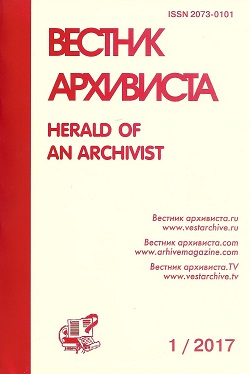Scientific article
УДК 930.25+331.105.5+7.096+316.42+304.9+304.444+304.442+612.84/.88+316.6+001.94+001.92+003.62+001.61+311.218+651.928+008.2+372.83+37.014+81'373.23+392.71+74.01/.09+910.2+727.94+727.98+912.4+914/919
doi 10.28995/2073-0101-2023-3-739-752
Golovnev, Ivan A., Golovneva, Elena V.
Peter the Great Museum of Anthropology and Ethnography, Russian Academy of Sciences, St. Petersburg, Russian Federation
“Cinema–Atlas of the USSR”: The Concept of M. V. Naletny: Archival Materials of the 1920s
Abstract
The 1920s saw an increased general release of documentaries about life of peoples and regions in the USSR, opening an opportunity for mass audience to make virtual trips through multinational and diverse country. It was within the frameworks of the project “Cinema-Atlas of the USSR,” an ambitious state program launched under the auspices of the Central Executive Committee, which involved creation of a 150-episode thematic film almanac. The article is to introduce into scientific use the archival documentary film “To the shores of the Pacific Ocean” (1927) directed by M. V. Naletny, created during complex film expedition along the Trans-Siberian railway from Moscow to the Far East. To achieve this goal, not only the film itself is analyzed, but also socio-political, cultural, and ideological context of its creation, in line with the state program for creation of the Soviet Cine-Atlas. Little-known visual and text archives, as well as data from the Soviet periodical press of the 1920s, are used as a source base for the study. Due to specifics of silent cinema, this film is a film text of a kind, consisting of approximately equal number of alternating film frames and text captions. One can tell that, in accordance with general recommendations for film making in the USSR, based on Marxist theory, the director designed his full-length film as a series of visual essays suitable for the “Cinema-Atlas” developed at the time. The study makes it obvious that M. V. Naletny sought in his film to overcome the format of superficial “tourist” narrative, widespread at the time, detailing geographical features of regions, types of population, their economic structures, etc. M. V. Naletny’s methodological developments, which are considered cocurrently, clearly demonstrate party requirements to capacious resources of cinematography as a means of information and agitation, textbook, and means for popularization of scientific knowledge. It is concluded that M. V. Naletny’s legacy is of multi-layered popular science significance, having become a contribution to the on-screen chronicle of Soviet transformations on the ground. The studied complex of materials is a significant example of visual and anthropological searches of the early Soviet period, as well as an informative historical source that has not lost its relevance for modern scientific study.
Keywords
Cinema-Atlas of the USSR, archival cinema-document, historical sources, visual anthropology
Download the article: golovnev_golovneva_doi
References
GOLOVNEV, I. A. Obrazy sovetskoi kolonizatsii v arkhivnom kino: “Evrei na zemle” Abrama Rooma. 1920–1930-e gg. [Images of Soviet Colonization in Archival Cinema: “Jews on the Earth” by Abram Room: The 1920s–30s. In Russ.]. IN: Vestnik arhivista / Herald of an Archivist, 2021, no. 4, pp. 1051-1063. doi 10.28995/2073-0101-2021-4-1051-1063
GOLOVNEV, I. A. Kinoatlas SSSR: “Kamchatka” Nikolaya Konstantinova (1927) [Cinema-Atlas of the USSR: “Kamchatka” by Nikolai Konstantinov (1927). In Russ.]. IN: Dialog so vremenem, 2022, no. 79, pp. 213–227.
GOLOVNEVA, E. V. Kamchatka v industrial'nom fotoreportazhe G. Z. Gaidukevicha (1930-e gg.) [Kamchatka in an industrial photo essay by G. Z. Gaidukevich (1930s). In Russ.]. IN: Sibirskie istoricheskie issledovaniya, 2022, no. 2, pp. 159–180.
KASYANOV, V. Kino-atlas SSSR (v poryadke predlozheniya) [Cinema-Atlas of the USSR (in order of proposal). In Russ.]. IN: Kino, 1926, no. 48, p. 1.
MAGIDOV, V. M. Kinoatlas SSSR: Istoriya sozdaniya serii fil'mov po vizual'noi antropologii [Cinema-Atlas of the USSR: The History of the Creation of a Series of Films on Visual Anthropology. In Russ.]. IN: Audiovizual'naya antropologiya. Istoriya s prodolzheniem [Audiovisual Anthropology. Story to be continued. In Russ.]. Moscow, 2008, pp. 136–141.
About the authors
Golovnev Ivan Andreevich, PhD in History, Peter the Great Museum of Anthropology and Ethnography, Russian Academy of Sciences, senior researcher, St. Petersburg, Russian Federation, +7-922-152-47-99, This e-mail address is being protected from spambots. You need JavaScript enabled to view it
Golovneva Elena Valentinovna, PhD in Philosophy, Peter the Great Museum of Anthropology and Ethnography, Russian Academy of Sciences, senior researcher, St. Petersburg State University, professor, St. Petersburg, Russian Federation, +7-922-152-47-99, This e-mail address is being protected from spambots. You need JavaScript enabled to view it
Grant information
This research has been supported by the Russian Science Foundation as a part of the project no. 21-18-00518, https://rscf.ru/en/project/21-18-00518/
Submitted 2.02.2023, published (for citation):
GOLOVNEV, I. A., GOLOVNEVA, E. V. “Kinoatlas SSSR”: kontseptsiya M. V. Naletnogo. Po arkhivnym materialam 1920-kh gg. [“Cinema–Atlas of the USSR”: The Concept of M. V. Naletny: Archival Materials of the 1920s. In Russ.]. IN: Vestnik arhivista / Herald of an Archivist, 2023, no. 3, pp. 739-752. doi 10.28995/2073-0101-2023-3-739-752














